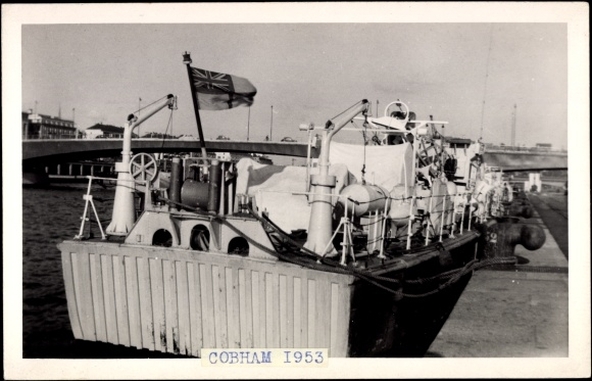
H.M.S. Cobham was a 'Ham' class inshore minesweeper launched in 1953, sold 1966 in Singapore.
If you have any information relating to H.M.S. Cobham please contact CaSHS via the project page.
The Ham class was a class of inshore minesweepers (IMS), known as the Type 1, of the British Royal Navy. The class was designed to operate in the shallow water of rivers and estuaries. All of the ships in the class are named for British place names that end with -"ham." The parent firm that was responsible for supervising construction was Samuel White of Cowes, Isle of Wight. The class consisted of 93 ships, launched between 1954 and 1959. HMS Inglesham was the first. The vessels displaced 164tons fully laden and were armed with one 40 mm Bofors or 20 mm Oerlikon gun. They were 32.5 metres (107 ft) long overall with a 6.4-metre (21 ft) beam. The construction was of wood to minimise magnetic signature. The crew complement was 15, rising to 22 in wartime. The engines of this class were Paxman diesels, some of which were built under licence by Ruston and Hornsby of Lincoln. Each vessel had: two 12YHAXM (intercooled) for main propulsion, rated at 550 bhp (410 kW) at 1,000 rpm, plus one 12YHAZ for pulse generation. Maximum speed was 14 knots (26 km/h; 16 mph) dropping to 9 knots (17 km/h; 10 mph) when mine sweeping. The class shared the same basic hull as the Ley-class minehunter and the Echo-class inshore survey craft.
If you have any information relating to H.M.S. Cobham please contact CaSHS via the project page.
The Ham class was a class of inshore minesweepers (IMS), known as the Type 1, of the British Royal Navy. The class was designed to operate in the shallow water of rivers and estuaries. All of the ships in the class are named for British place names that end with -"ham." The parent firm that was responsible for supervising construction was Samuel White of Cowes, Isle of Wight. The class consisted of 93 ships, launched between 1954 and 1959. HMS Inglesham was the first. The vessels displaced 164tons fully laden and were armed with one 40 mm Bofors or 20 mm Oerlikon gun. They were 32.5 metres (107 ft) long overall with a 6.4-metre (21 ft) beam. The construction was of wood to minimise magnetic signature. The crew complement was 15, rising to 22 in wartime. The engines of this class were Paxman diesels, some of which were built under licence by Ruston and Hornsby of Lincoln. Each vessel had: two 12YHAXM (intercooled) for main propulsion, rated at 550 bhp (410 kW) at 1,000 rpm, plus one 12YHAZ for pulse generation. Maximum speed was 14 knots (26 km/h; 16 mph) dropping to 9 knots (17 km/h; 10 mph) when mine sweeping. The class shared the same basic hull as the Ley-class minehunter and the Echo-class inshore survey craft.
